tow Seat Alhambra 2011 Owner's Manual
[x] Cancel search | Manufacturer: SEAT, Model Year: 2011, Model line: Alhambra, Model: Seat Alhambra 2011Pages: 385, PDF Size: 7.92 MB
Page 5 of 385
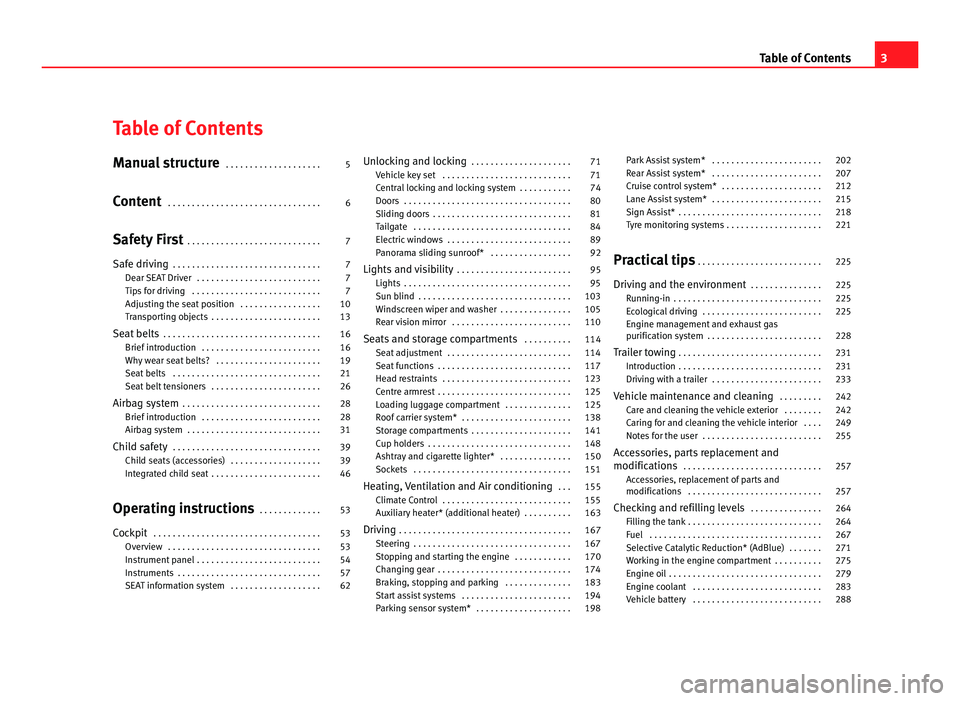
Table of Contents
Manual structure
. . . . . . . . . . . . . . . . . . . . 5
Content . . . . . . . . . . . . . . . . . . . . . . . . . . . . . . . . 6
Safety First . . . . . . . . . . . . . . . . . . . . . . . . . . . . 7
Safe driving . . . . . . . . . . . . . . . . . . . . . . . . . . . . . . . 7
Dear SEAT Driver . . . . . . . . . . . . . . . . . . . . . . . . . . 7
Tips for driving . . . . . . . . . . . . . . . . . . . . . . . . . . . 7
Adjusting the seat position . . . . . . . . . . . . . . . . . 10
Transporting objects . . . . . . . . . . . . . . . . . . . . . . . 13
Seat belts . . . . . . . . . . . . . . . . . . . . . . . . . . . . . . . . . 16
Brief introduction . . . . . . . . . . . . . . . . . . . . . . . . . 16
Why wear seat belts? . . . . . . . . . . . . . . . . . . . . . . 19
Seat belts . . . . . . . . . . . . . . . . . . . . . . . . . . . . . . . 21
Seat belt tensioners . . . . . . . . . . . . . . . . . . . . . . . 26
Airbag system . . . . . . . . . . . . . . . . . . . . . . . . . . . . . 28
Brief introduction . . . . . . . . . . . . . . . . . . . . . . . . . 28
Airbag system . . . . . . . . . . . . . . . . . . . . . . . . . . . . 31
Child safety . . . . . . . . . . . . . . . . . . . . . . . . . . . . . . . 39
Child seats (accessories) . . . . . . . . . . . . . . . . . . . 39
Integrated child seat . . . . . . . . . . . . . . . . . . . . . . . 46
Operating instructions . . . . . . . . . . . . . 53
Cockpit . . . . . . . . . . . . . . . . . . . . . . . . . . . . . . . . . . . 53
Overview . . . . . . . . . . . . . . . . . . . . . . . . . . . . . . . . 53
Instrument panel . . . . . . . . . . . . . . . . . . . . . . . . . . 54
Instruments . . . . . . . . . . . . . . . . . . . . . . . . . . . . . . 57
SEAT information system . . . . . . . . . . . . . . . . . . . 62 Unlocking and locking
. . . . . . . . . . . . . . . . . . . . . 71
Vehicle key set . . . . . . . . . . . . . . . . . . . . . . . . . . . 71
Central locking and locking system . . . . . . . . . . . 74
Doors . . . . . . . . . . . . . . . . . . . . . . . . . . . . . . . . . . . 80
Sliding doors . . . . . . . . . . . . . . . . . . . . . . . . . . . . . 81
Tailgate . . . . . . . . . . . . . . . . . . . . . . . . . . . . . . . . . 84
Electric windows . . . . . . . . . . . . . . . . . . . . . . . . . . 89
Panorama sliding sunroof* . . . . . . . . . . . . . . . . . 92
Lights and visibility . . . . . . . . . . . . . . . . . . . . . . . . 95
Lights . . . . . . . . . . . . . . . . . . . . . . . . . . . . . . . . . . . 95
Sun blind . . . . . . . . . . . . . . . . . . . . . . . . . . . . . . . . 103
Windscreen wiper and washer . . . . . . . . . . . . . . . 105
Rear vision mirror . . . . . . . . . . . . . . . . . . . . . . . . . 110
Seats and storage compartments . . . . . . . . . . 114
Seat adjustment . . . . . . . . . . . . . . . . . . . . . . . . . . 114
Seat functions . . . . . . . . . . . . . . . . . . . . . . . . . . . . 117
Head restraints . . . . . . . . . . . . . . . . . . . . . . . . . . . 123
Centre armrest . . . . . . . . . . . . . . . . . . . . . . . . . . . . 125
Loading luggage compartment . . . . . . . . . . . . . . 125
Roof carrier system* . . . . . . . . . . . . . . . . . . . . . . . 138
Storage compartments . . . . . . . . . . . . . . . . . . . . . 141
Cup holders . . . . . . . . . . . . . . . . . . . . . . . . . . . . . . 148
Ashtray and cigarette lighter* . . . . . . . . . . . . . . . 150
Sockets . . . . . . . . . . . . . . . . . . . . . . . . . . . . . . . . . 151
Heating, Ventilation and Air conditioning . . . 155
Climate Control . . . . . . . . . . . . . . . . . . . . . . . . . . . 155
Auxiliary heater* (additional heater) . . . . . . . . . . 163
Driving . . . . . . . . . . . . . . . . . . . . . . . . . . . . . . . . . . . . 167
Steering . . . . . . . . . . . . . . . . . . . . . . . . . . . . . . . . . 167
Stopping and starting the engine . . . . . . . . . . . . 170
Changing gear . . . . . . . . . . . . . . . . . . . . . . . . . . . . 174
Braking, stopping and parking . . . . . . . . . . . . . . 183
Start assist systems . . . . . . . . . . . . . . . . . . . . . . . 194
Parking sensor system* . . . . . . . . . . . . . . . . . . . . 198 Park Assist system* . . . . . . . . . . . . . . . . . . . . . . . 202
Rear Assist system* . . . . . . . . . . . . . . . . . . . . . . . 207
Cruise control system* . . . . . . . . . . . . . . . . . . . . . 212
Lane Assist system* . . . . . . . . . . . . . . . . . . . . . . . 215
Sign Assist* . . . . . . . . . . . . . . . . . . . . . . . . . . . . . . 218
Tyre monitoring systems . . . . . . . . . . . . . . . . . . . . 221
Practical tips . . . . . . . . . . . . . . . . . . . . . . . . . . 225
Driving and the environment . . . . . . . . . . . . . . . 225
Running-in . . . . . . . . . . . . . . . . . . . . . . . . . . . . . . . 225
Ecological driving . . . . . . . . . . . . . . . . . . . . . . . . . 225
Engine management and exhaust gas
purific ation sy
stem . . . . . . . . . . . . . . . . . . . . . . . . 228
Trailer towing . . . . . . . . . . . . . . . . . . . . . . . . . . . . . . 231
Introduction . . . . . . . . . . . . . . . . . . . . . . . . . . . . . . 231
Driving with a trailer . . . . . . . . . . . . . . . . . . . . . . . 233
Vehicle maintenance and cleaning . . . . . . . . . 242
Care and cleaning the vehicle exterior . . . . . . . . 242
Caring for and cleaning the vehicle interior . . . . 249
Notes for the user . . . . . . . . . . . . . . . . . . . . . . . . . 255
Accessories, parts replacement and
modifications . . . . . . . . . . . . . . . . . . . . . . . . . . . . .
257
Accessories, replacement of parts and
modifications
. . . . . . . . . . . . . . . . . . . . . . . . . . . . 257
Checking and refilling levels . . . . . . . . . . . . . . . 264
Filling the tank . . . . . . . . . . . . . . . . . . . . . . . . . . . . 264
Fuel . . . . . . . . . . . . . . . . . . . . . . . . . . . . . . . . . . . . 267
Selective Catalytic Reduction* (AdBlue) . . . . . . . 271
Working in the engine compartment . . . . . . . . . . 275
Engine oil . . . . . . . . . . . . . . . . . . . . . . . . . . . . . . . . 279
Engine coolant . . . . . . . . . . . . . . . . . . . . . . . . . . . 283
Vehicle battery . . . . . . . . . . . . . . . . . . . . . . . . . . . 288 3
Table of Contents
Page 6 of 385
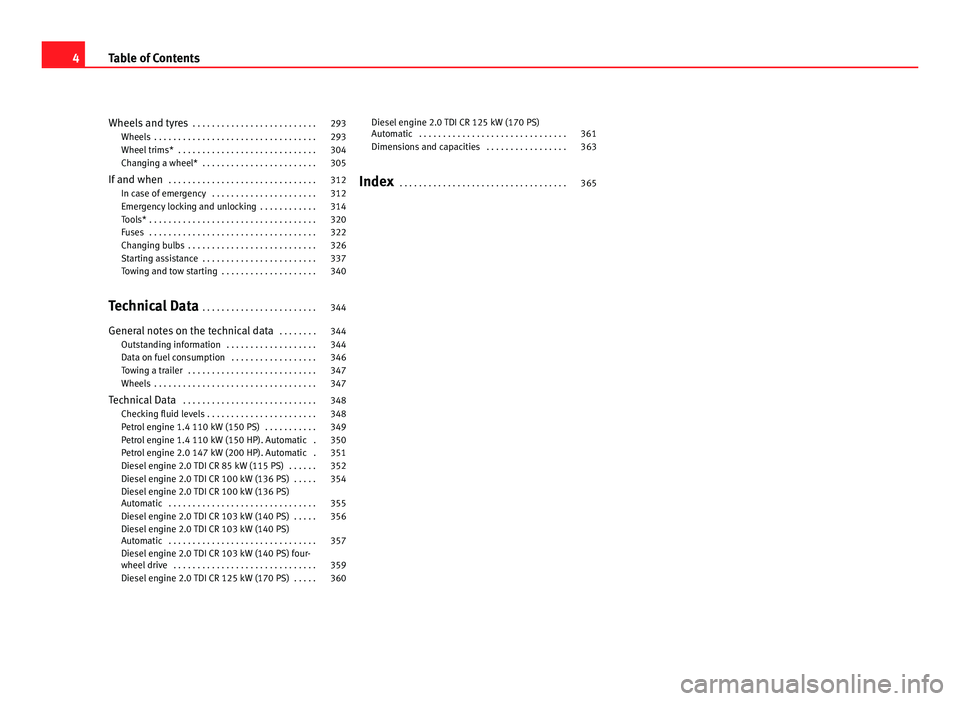
Wheels and tyres
. . . . . . . . . . . . . . . . . . . . . . . . . . 293
Wheels . . . . . . . . . . . . . . . . . . . . . . . . . . . . . . . . . . 293
Wheel trims* . . . . . . . . . . . . . . . . . . . . . . . . . . . . . 304
Changing a wheel* . . . . . . . . . . . . . . . . . . . . . . . . 305
If and when . . . . . . . . . . . . . . . . . . . . . . . . . . . . . . . 312
In case of emergency . . . . . . . . . . . . . . . . . . . . . . 312
Emergency locking and unlocking . . . . . . . . . . . . 314
Tools* . . . . . . . . . . . . . . . . . . . . . . . . . . . . . . . . . . . 320
Fuses . . . . . . . . . . . . . . . . . . . . . . . . . . . . . . . . . . . 322
Changing bulbs . . . . . . . . . . . . . . . . . . . . . . . . . . . 326
Starting assistance . . . . . . . . . . . . . . . . . . . . . . . . 337
Towing and tow starting . . . . . . . . . . . . . . . . . . . . 340
Technical Data . . . . . . . . . . . . . . . . . . . . . . . . 344
General notes on the technical data . . . . . . . . 344
Outstanding information . . . . . . . . . . . . . . . . . . . 344
Data on fuel consumption . . . . . . . . . . . . . . . . . . 346
Towing a trailer . . . . . . . . . . . . . . . . . . . . . . . . . . . 347
Wheels . . . . . . . . . . . . . . . . . . . . . . . . . . . . . . . . . . 347
Technical Data . . . . . . . . . . . . . . . . . . . . . . . . . . . . 348
Checking fluid levels . . . . . . . . . . . . . . . . . . . . . . . 348
Petrol engine 1.4 110 kW (150 PS) . . . . . . . . . . . 349
Petrol engine 1.4 110 kW (150 HP). Automatic . 350
Petrol engine 2.0 147 kW (200 HP). Automatic . 351
Diesel engine 2.0 TDI CR 85 kW (115 PS) . . . . . . 352
Diesel engine 2.0 TDI CR 100 kW (136 PS) . . . . . 354
Diesel engine 2.0 TDI CR 100 kW (136 PS)
Autom atic
. . . . . . . . . . . . . . . . . . . . . . . . . . . . . . . 355
Diesel engine 2.0 TDI CR 103 kW (140 PS) . . . . . 356
Diesel engine 2.0 TDI CR 103 kW (140 PS)
Automatic
. . . . . . . . . . . . . . . . . . . . . . . . . . . . . . . 357
Diesel engine 2.0 TDI CR 103 kW (140 PS) four-
wheel drive
. . . . . . . . . . . . . . . . . . . . . . . . . . . . . . 359
Diesel engine 2.0 TDI CR 125 kW (170 PS) . . . . . 360 Diesel engine 2.0 TDI CR 125 kW (170 PS)
Automatic
. . . . . . . . . . . . . . . . . . . . . . . . . . . . . . . 361
Dimensions and capacities . . . . . . . . . . . . . . . . . 363
Index . . . . . . . . . . . . . . . . . . . . . . . . . . . . . . . . . . . 3654
Table of Contents
Page 10 of 385

8
Safe driving
● Check that the lights and turn signals operate correctly.
● Chec k
the tyre pressures ( ⇒ pag
e 293) and level of fuel (⇒ page 264).
● Ensure there is good visibility through all the windows.
● Make sure that all objects and bags in the storage compartments, in the
luggag
e compartment and, where applicable, on the roof, are securely fas-
tened ⇒ page 13.
● Ensure there is nothing obstructing the free passage of the foot pedals.
● Use child retention systems appropriate for the child's body weight and
height ⇒
page 39.
● Correctly adjust front seat, head rests and rear-view mirrors to suit your
height ⇒
page 10.
● Wear close-fitting shoes which do not prevent you from using the pedals
correctly
.
● The driver's floor mat should be fixed to the floor, leaving the pedal area
unob
structed.
● Before starting out, ensure you are correctly seated and remain in this
position thr
oughout the journey. This applies to all passengers in the vehi-
cle ⇒ page 10.
● Correctly fasten your seat belt before starting to drive and keep it se-
curely
fastened throughout the journey. This applies to all passengers in the
vehicle ⇒ page 21.
● Never carry more passengers than the number of available seats and
seat belts
in your vehicle.
● Never drive with impaired faculties (for example, due to medication, al-
cohol
or drugs).
● Do not allow yourself to be distracted from the traffic, for example, to re-
set or swit
ch on a menu, by other passengers or to answer a phone call.
● Always try to adapt the speed of the vehicle and your style of driving to
the condition of the gr
ound or the road and to weather and traffic condi-
tions.
● Observe the highway code and speed limits. ●
On long journeys, rest at regular intervals (at least every two hours).
● If c
arrying animals, make sure they are correctly restrained in accord-
ance with their w
eight and size. WARNING
Always observe traffic regulations and speed limits and try to anticipate
traffic mo
vements. Correctly anticipating traffic situations may mean the
difference between arriving safe and sound at your destination or having
a serious accident. Note
Regular servicing of your vehicle not only helps to keep it in good working
order b ut
also helps to ensure road safety. Therefore, please ensure the ve-
hicle is taken for service as indicated in the Maintenance Programme. If the
vehicle is subjected to hard use, it may require certain maintenance work
before the next service date. Hard use may involve frequent driving in traffic
jams, driving in dusty areas or frequent use of the tow-bar. For further infor-
mation, please refer to a SEAT dealer or specialised workshop.
Driving abroad Check list
In some cou
ntrie
s, certain safety regulations and requirements are in force
relating to exhaust gas emissions, which differ from the technical character-
istics of the vehicle. Before travelling abroad, SEAT recommends you con-
sult a SEAT dealer about the legal requirements and the following points:
● Does the vehicle need technical modifications for driving abroad, for ex-
ample, a
djustment of the headlamps?
● Does the vehicle have all the tools, diagnostics equipment and spare
parts
required for inspections and repairs?
● Are there any SEAT dealers in the destination country?
Page 18 of 385
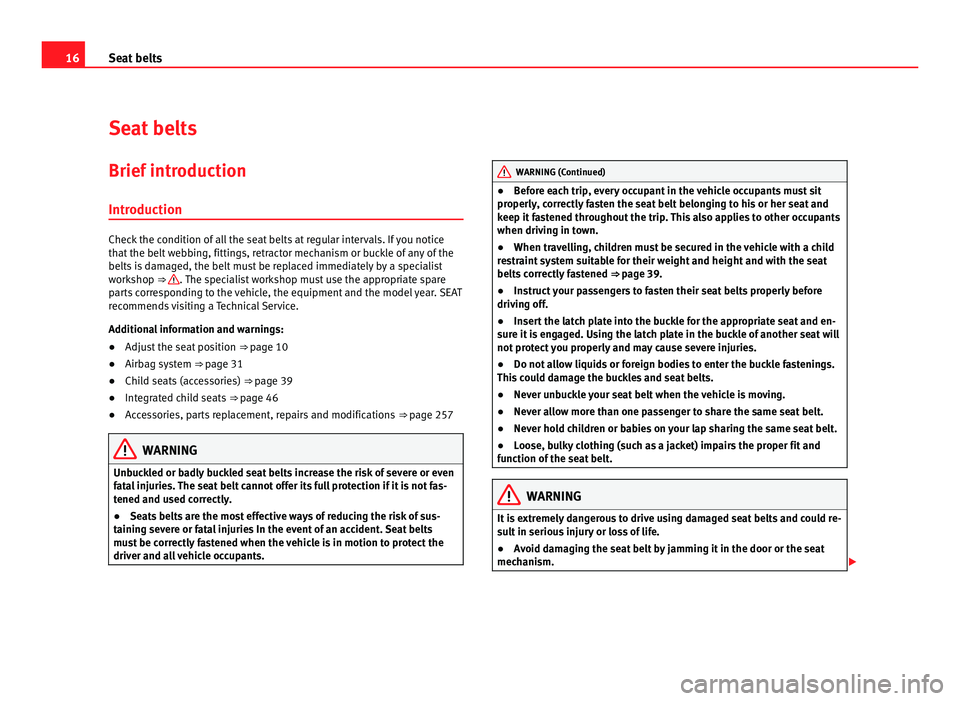
16
Seat belts
Seat belts
Brief introduction Introduction Check the condition of all the seat belts at regular intervals. If you notice
that
the belt
webbing, fittings, retractor mechanism or buckle of any of the
belts is damaged, the belt must be replaced immediately by a specialist
workshop ⇒ . The specialist workshop must use the appropriate spare
par ts
corresponding to the vehicle, the equipment and the model year. SEAT
recommends visiting a Technical Service.
Additional information and warnings:
● Adjust the seat position ⇒ page 10
● Airb
ag system ⇒ page 31
● Chi
ld seats (accessories) ⇒ page 39
● Int
egrated child seats ⇒ page 46
● A
ccessories, parts replacement, repairs and modifications ⇒ page 257WARNING
Unbuckled or badly buckled seat belts increase the risk of severe or even
fat a
l injuries. The seat belt cannot offer its full protection if it is not fas-
tened and used correctly.
● Seats belts are the most effective ways of reducing the risk of sus-
taining sev
ere or fatal injuries In the event of an accident. Seat belts
must be correctly fastened when the vehicle is in motion to protect the
driver and all vehicle occupants. WARNING (Continued)
● Before each trip, every occupant in the vehicle occupants must sit
pr operly
, correctly fasten the seat belt belonging to his or her seat and
keep it fastened throughout the trip. This also applies to other occupants
when driving in town.
● When travelling, children must be secured in the vehicle with a child
res
traint system suitable for their weight and height and with the seat
belts correctly fastened ⇒ page 39.
● Instruct your passengers to fasten their seat belts properly before
driving off
.
● Insert the latch plate into the buckle for the appropriate seat and en-
sure it
is engaged. Using the latch plate in the buckle of another seat will
not protect you properly and may cause severe injuries.
● Do not allow liquids or foreign bodies to enter the buckle fastenings.
This c
ould damage the buckles and seat belts.
● Never unbuckle your seat belt when the vehicle is moving.
● Never allow more than one passenger to share the same seat belt.
● Never hold children or babies on your lap sharing the same seat belt.
● Loose, bulky clothing (such as a jacket) impairs the proper fit and
function of
the seat belt. WARNING
It is extremely dangerous to drive using damaged seat belts and could re-
su lt
in serious injury or loss of life.
● Avoid damaging the seat belt by jamming it in the door or the seat
mechani
sm.
Page 40 of 385
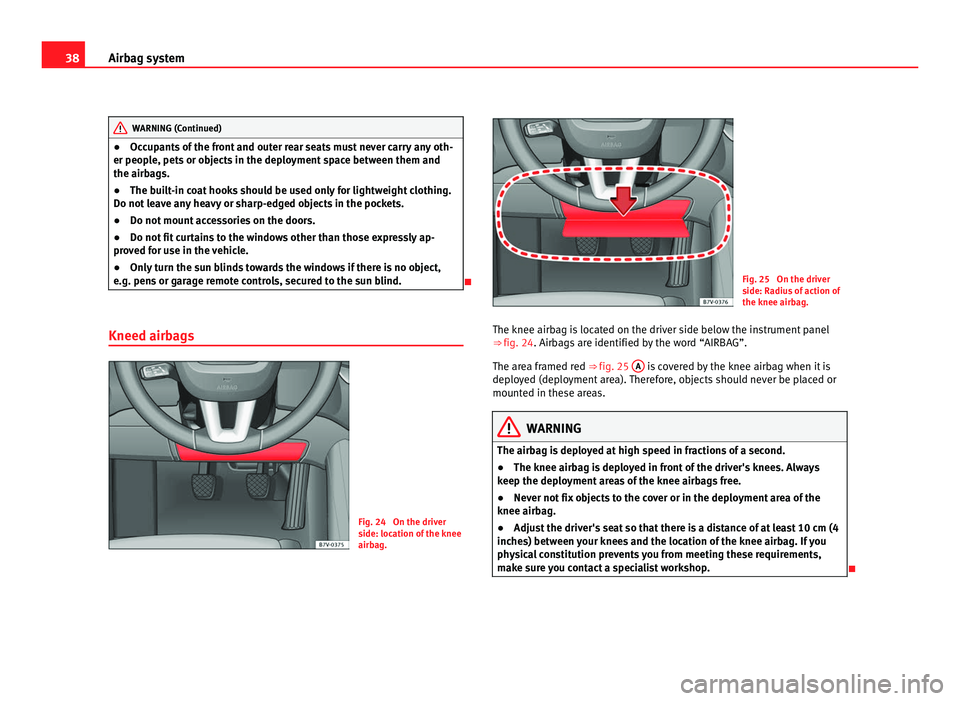
38
Airbag system WARNING (Continued)
● Occupants of the front and outer rear seats must never carry any oth-
er peop l
e, pets or objects in the deployment space between them and
the airbags.
● The built-in coat hooks should be used only for lightweight clothing.
Do not le
ave any heavy or sharp-edged objects in the pockets.
● Do not mount accessories on the doors.
● Do not fit curtains to the windows other than those expressly ap-
prov
ed for use in the vehicle.
● Only turn the sun blinds towards the windows if there is no object,
e.g. pens
or garage remote controls, secured to the sun blind.
Kneed airbags Fig. 24 On the driver
side: loc
ation of
the knee
airbag. Fig. 25 On the driver
side: R
a
dius of action of
the knee airbag.
The knee airbag is located on the driver side below the instrument panel
⇒ fig. 24. Airbags
are identified by the word “AIRBAG”.
The area framed red ⇒ fig. 25 A is covered by the knee airbag when it is
deplo y
ed (deployment area). Therefore, objects should never be placed or
mounted in these areas. WARNING
The airbag is deployed at high speed in fractions of a second.
● The knee airbag is deployed in front of the driver's knees. Always
keep the dep lo
yment areas of the knee airbags free.
● Never not fix objects to the cover or in the deployment area of the
knee airbag.
● Adjus
t the driver's seat so that there is a distance of at least 10 cm (4
inches) betw
een your knees and the location of the knee airbag. If you
physical constitution prevents you from meeting these requirements,
make sure you contact a specialist workshop.
Page 79 of 385
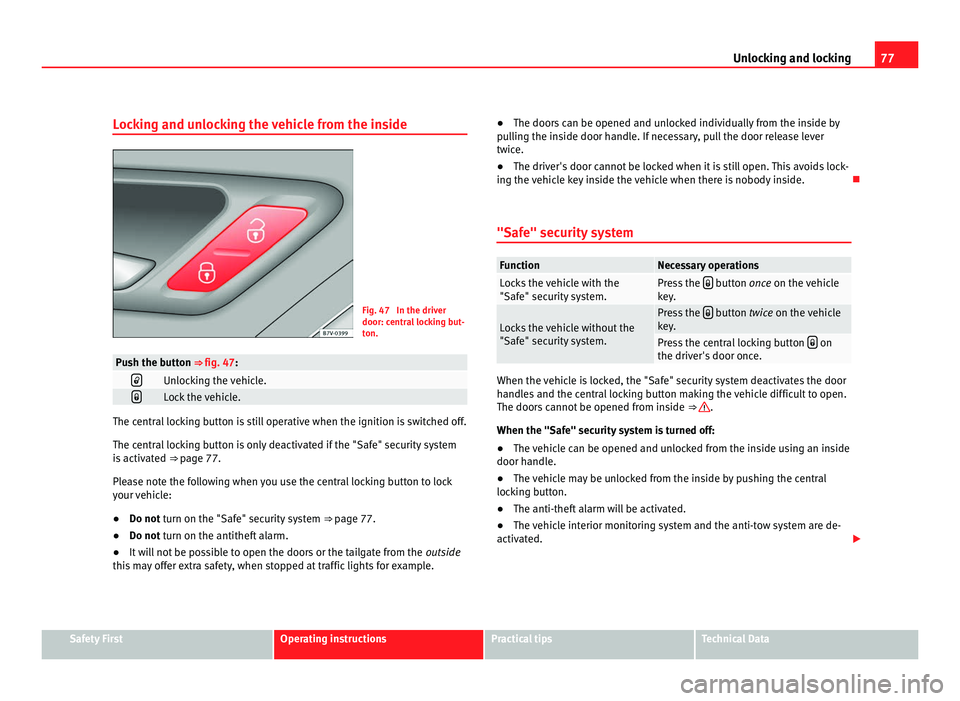
77
Unlocking and locking
Locking and unlocking the vehicle from the inside Fig. 47 In the driver
door: centr
a
l locking but-
ton. Push the button ⇒ fig. 47:
Unlocking the vehicle.
Lock the vehicle.
The central locking button is still operative when the ignition is switched off.
The centr
al
locking button is only deactivated if the "Safe" security system
is activated ⇒ page 77.
Please note the following when you use the central locking button to lock
your vehicle:
● Do not turn on the "Safe" security system ⇒ pag
e 77.
● Do not turn on the antitheft alarm.
● It w
ill not be possible to open the doors or the tailgate from the outside
this
may offer extra safety, when stopped at traffic lights for example. ●
The doors c
an be opened and unlocked individually from the inside by
pulling the inside door handle. If necessary, pull the door release lever
twice.
● The driver's door cannot be locked when it is still open. This avoids lock-
ing the v
ehicle key inside the vehicle when there is nobody inside.
"Safe" security system Function Necessary operations
Locks the vehicle with the
"Safe" sec
urity
system. Press the
button once on the vehicle
k ey
. Locks the vehicle without the
"Safe" sec
urity
system. Press the
button twice on the vehicle
k ey
. Press the central locking button
on
the driver's door onc
e. When the vehicle is locked, the "Safe" security system deactivates the door
handl
e
s and the central locking button making the vehicle difficult to open.
The doors cannot be opened from inside ⇒ .
When the "Safe" sec urity
system is turned off:
● The vehicle can be opened and unlocked from the inside using an inside
door handle.
● The
vehicle may be unlocked from the inside by pushing the central
lockin
g button.
● The anti-theft alarm will be activated.
● The vehicle interior monitoring system and the anti-tow system are de-
activated. Safety First Operating instructions Practical tips Technical Data
Page 80 of 385
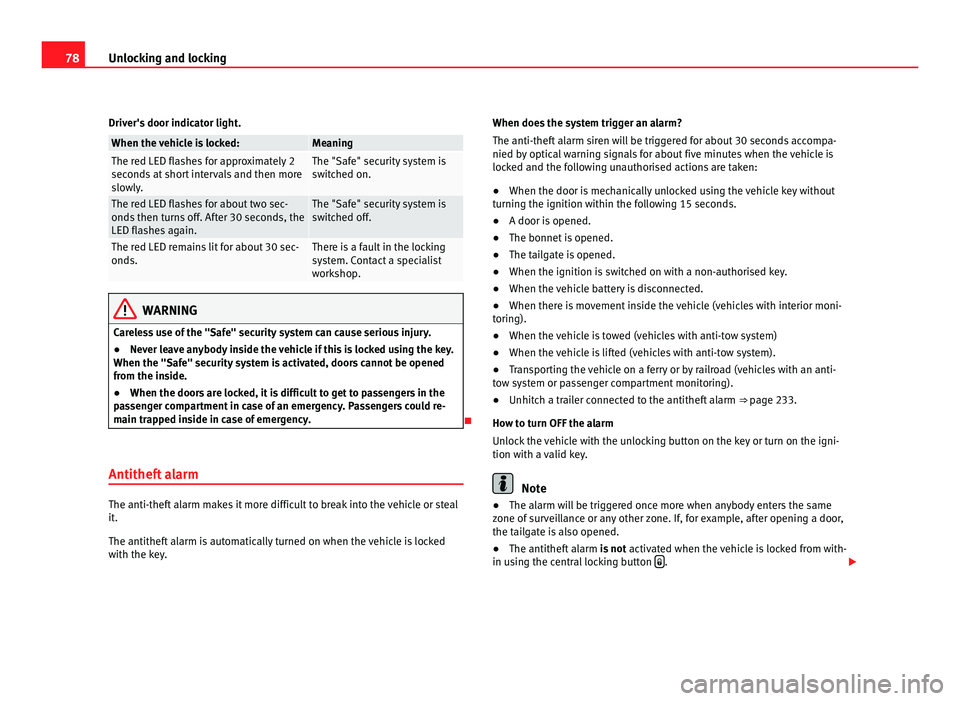
78
Unlocking and locking
Driver's door indicator light. When the vehicle is locked: Meaning
The red LED flashes for approximately 2
second
s
at short intervals and then more
slowly. The "Safe" security system is
swit
c
hed on. The red LED flashes for about two sec-
onds
then t
urns off. After 30 seconds, the
LED flashes again. The "Safe" security system is
swit
c
hed off. The red LED remains lit for about 30 sec-
onds. There is a fault in the locking
sys
t
em. Contact a specialist
workshop. WARNING
Careless use of the "Safe" security system can cause serious injury.
● Never leave anybody inside the vehicle if this is locked using the key.
When the "Safe" sec urity
system is activated, doors cannot be opened
from the inside.
● When the doors are locked, it is difficult to get to passengers in the
pas
senger compartment in case of an emergency. Passengers could re-
main trapped inside in case of emergency.
Antitheft alarm The anti-theft alarm makes it more difficult to break into the vehicle or steal
it.
The antithef
t
alarm is automatically turned on when the vehicle is locked
with the key. When does the system trigger an alarm?
The anti-theft al
arm siren will be triggered for about 30 seconds accompa-
nied by optical warning signals for about five minutes when the vehicle is
locked and the following unauthorised actions are taken:
● When the door is mechanically unlocked using the vehicle key without
turning the ignition w
ithin the following 15 seconds.
● A door is opened.
● The bonnet is opened.
● The tailgate is opened.
● When the ignition is switched on with a non-authorised key.
● When the vehicle battery is disconnected.
● When there is movement inside the vehicle (vehicles with interior moni-
toring).
● When the
vehicle is towed (vehicles with anti-tow system)
● When the vehicle is lifted (vehicles with anti-tow system).
● Transporting the vehicle on a ferry or by railroad (vehicles with an anti-
tow sy
stem or passenger compartment monitoring).
● Unhitch a trailer connected to the antitheft alarm ⇒ pag
e 233.
How to turn OFF the alarm
Unlock the vehicle with the unlocking button on the key or turn on the igni-
tion with a valid key. Note
● The alarm will be triggered once more when anybody enters the same
z one of
surveillance or any other zone. If, for example, after opening a door,
the tailgate is also opened.
● The antitheft alarm is not activ
ated when the vehicle is locked from with-
in using the central locking button .
Page 81 of 385
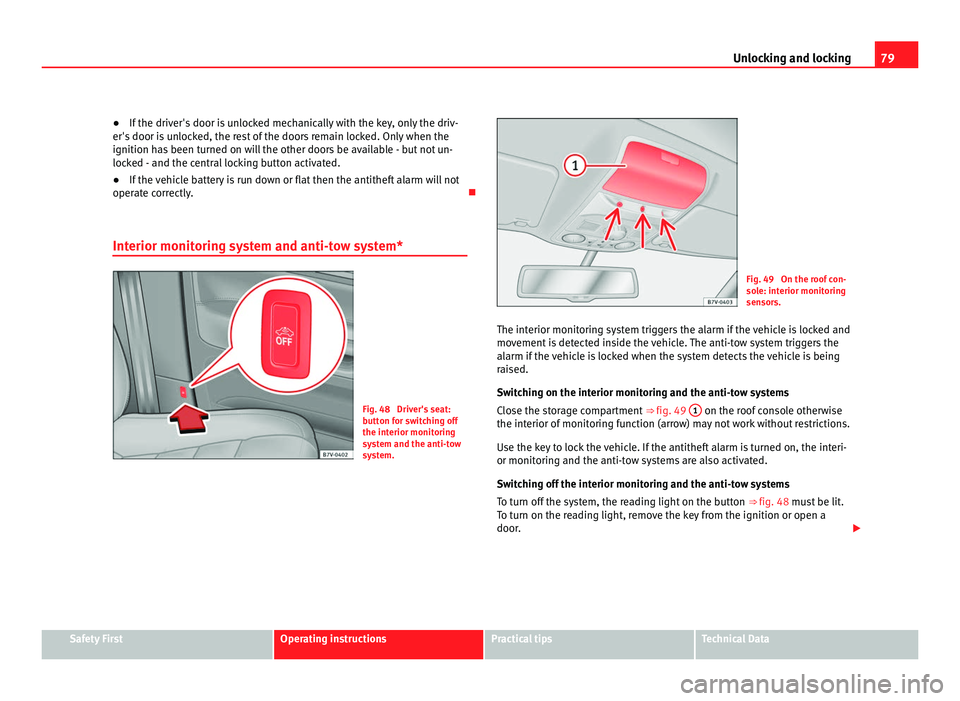
79
Unlocking and locking
● If the driver's door is unlocked mechanically with the key, only the driv-
er's door i
s unlocked, the rest of the doors remain locked. Only when the
ignition has been turned on will the other doors be available - but not un-
locked - and the central locking button activated.
● If the vehicle battery is run down or flat then the antitheft alarm will not
operate c
orrectly.
Interior monitoring system and anti-tow system* Fig. 48 Driver's seat:
butt
on f
or switching off
the interior monitoring
system and the anti-tow
system. Fig. 49 On the roof con-
sol
e: int
erior monitoring
sensors.
The interior monitoring system triggers the alarm if the vehicle is locked and
movement
is detected inside the vehicle. The anti-tow system triggers the
alarm if the vehicle is locked when the system detects the vehicle is being
raised.
Switching on the interior monitoring and the anti-tow systems
Close the storage compartment ⇒ fig. 49 1 on the roof console otherwise
the interior of monit
oring function (arrow) may not work without restrictions.
Use the key to lock the vehicle. If the antitheft alarm is turned on, the interi-
or monitoring and the anti-tow systems are also activated.
Switching off the interior monitoring and the anti-tow systems
To turn off the system, the reading light on the button ⇒ fig. 48 must be lit.
To turn on the reading light, remove the key from the ignition or open a
door. Safety First Operating instructions Practical tips Technical Data
Page 82 of 385
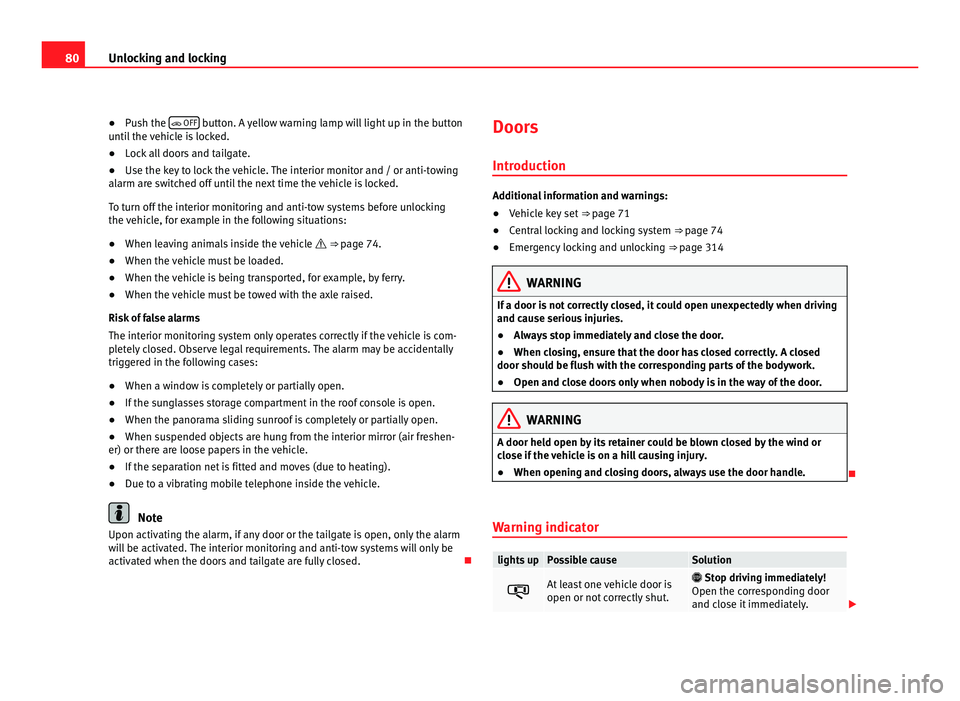
80
Unlocking and locking
● Push the
OFF button. A yellow warning lamp will light up in the button
unti l
the vehicle is locked.
● Lock all doors and tailgate.
● Use the key to lock the vehicle. The interior monitor and / or anti-towing
alarm are sw
itched off until the next time the vehicle is locked.
To turn off the interior monitoring and anti-tow systems before unlocking
the vehicle, for example in the following situations:
● When leaving animals inside the vehicle ⇒ page 74.
● When the
vehicle must be loaded.
● When the vehicle is being transported, for example, by ferry.
● When the vehicle must be towed with the axle raised.
Risk of
false alarms
The interior monitoring system only operates correctly if the vehicle is com-
pletely closed. Observe legal requirements. The alarm may be accidentally
triggered in the following cases:
● When a window is completely or partially open.
● If the sunglasses storage compartment in the roof console is open.
● When the panorama sliding sunroof is completely or partially open.
● When suspended objects are hung from the interior mirror (air freshen-
er) or there are loo
se papers in the vehicle.
● If the separation net is fitted and moves (due to heating).
● Due to a vibrating mobile telephone inside the vehicle. Note
Upon activating the alarm, if any door or the tailgate is open, only the alarm
wi l
l be activated. The interior monitoring and anti-tow systems will only be
activated when the doors and tailgate are fully closed. Doors
Introduction Additional information and warnings:
●
Vehicle key set ⇒ page 71
● C
entral locking and locking system ⇒ page 74
● Emer
gency locking and unlocking ⇒ page 314 WARNING
If a door is not correctly closed, it could open unexpectedly when driving
and cau se seriou
s injuries.
● Always stop immediately and close the door.
● When closing, ensure that the door has closed correctly. A closed
door should be flu
sh with the corresponding parts of the bodywork.
● Open and close doors only when nobody is in the way of the door. WARNING
A door held open by its retainer could be blown closed by the wind or
clo se if
the vehicle is on a hill causing injury.
● When opening and closing doors, always use the door handle.
Warning indicator lights up Possible cause Solution
At least one vehicle door is
open or not c
orr
ectly shut.
Stop driving immediately!
Open the c orr
esponding door
and close it immediately.
Page 86 of 385
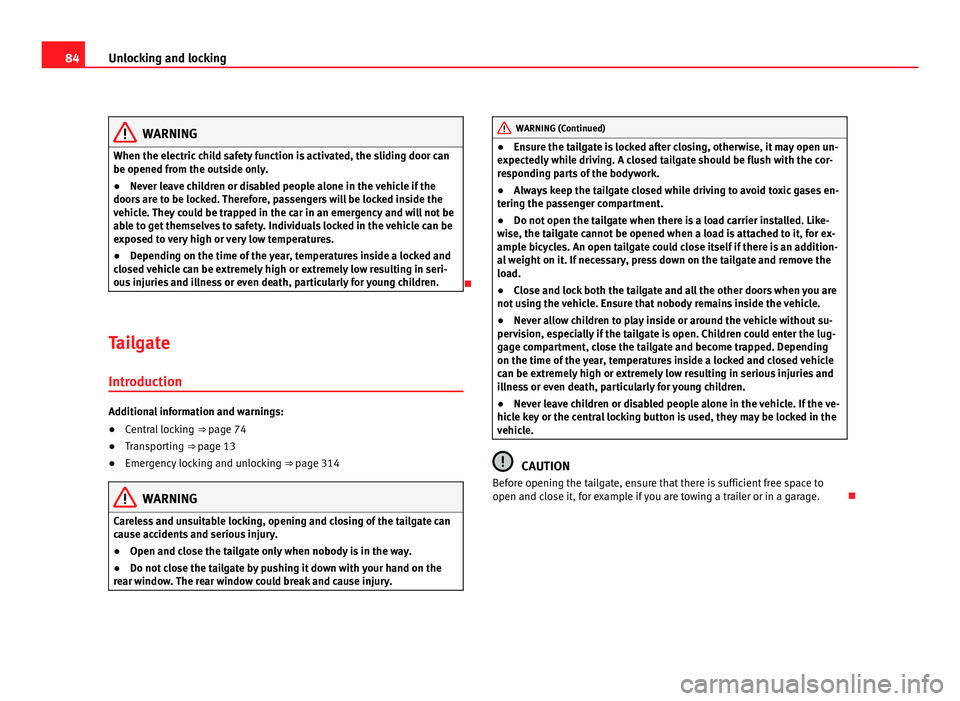
84
Unlocking and locking WARNING
When the electric child safety function is activated, the sliding door can
be opened from the out s
ide only.
● Never leave children or disabled people alone in the vehicle if the
doors ar
e to be locked. Therefore, passengers will be locked inside the
vehicle. They could be trapped in the car in an emergency and will not be
able to get themselves to safety. Individuals locked in the vehicle can be
exposed to very high or very low temperatures.
● Depending on the time of the year, temperatures inside a locked and
closed
vehicle can be extremely high or extremely low resulting in seri-
ous injuries and illness or even death, particularly for young children.
Tailgate Introduction Additional information and warnings:
●
Central locking ⇒ page 74
● T
ransporting ⇒ page 13
● Emer
gency locking and unlocking ⇒ page 314WARNING
Careless and unsuitable locking, opening and closing of the tailgate can
cau se ac
cidents and serious injury.
● Open and close the tailgate only when nobody is in the way.
● Do not close the tailgate by pushing it down with your hand on the
rear w
indow. The rear window could break and cause injury. WARNING (Continued)
● Ensure the tailgate is locked after closing, otherwise, it may open un-
e xpect
edly while driving. A closed tailgate should be flush with the cor-
responding parts of the bodywork.
● Always keep the tailgate closed while driving to avoid toxic gases en-
tering the p
assenger compartment.
● Do not open the tailgate when there is a load carrier installed. Like-
wise, the t
ailgate cannot be opened when a load is attached to it, for ex-
ample bicycles. An open tailgate could close itself if there is an addition-
al weight on it. If necessary, press down on the tailgate and remove the
load.
● Close and lock both the tailgate and all the other doors when you are
not us
ing the vehicle. Ensure that nobody remains inside the vehicle.
● Never allow children to play inside or around the vehicle without su-
pervi
sion, especially if the tailgate is open. Children could enter the lug-
gage compartment, close the tailgate and become trapped. Depending
on the time of the year, temperatures inside a locked and closed vehicle
can be extremely high or extremely low resulting in serious injuries and
illness or even death, particularly for young children.
● Never leave children or disabled people alone in the vehicle. If the ve-
hicle k
ey or the central locking button is used, they may be locked in the
vehicle. CAUTION
Before opening the tailgate, ensure that there is sufficient free space to
open and clo se it, f
or example if you are towing a trailer or in a garage.